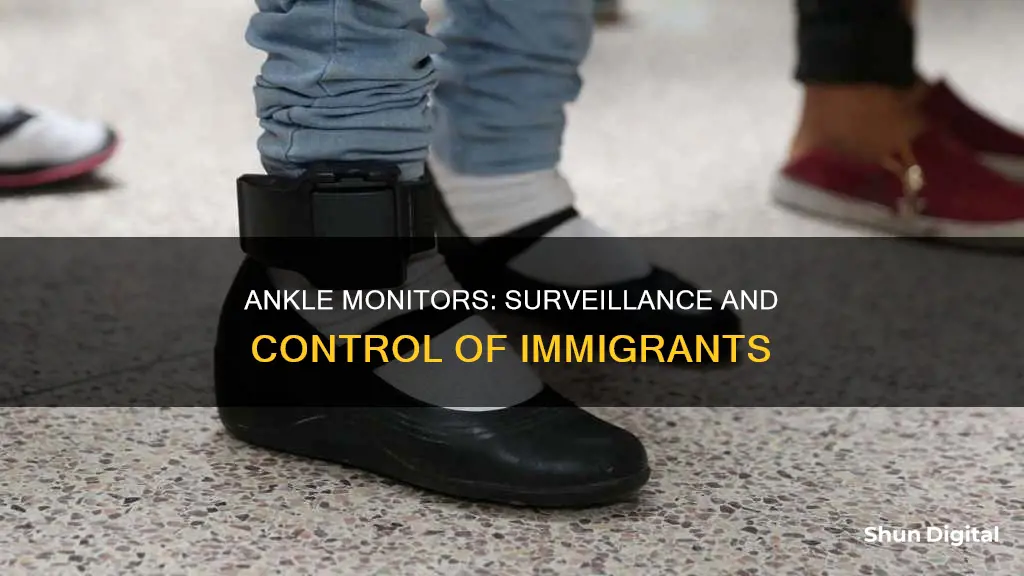
In recent years, the use of ankle monitors to track immigrants has become a growing phenomenon, particularly in the United States. Ankle monitors, also known as electronic shackles, are used as an alternative to detention for immigrants who are awaiting immigration court proceedings or deportation. The use of these monitors has been justified as a way to ensure immigrants show up for their court dates and don't flee from immigration enforcement. While some argue that ankle monitors are a more humane and cost-effective option than detention, there are also concerns about their negative impacts on the wearers' physical and mental health, as well as the social stigma and limitations on employment opportunities they may face.
| Characteristics | Values |
|---|---|
| Who uses ankle monitors | U.S. Immigration and Customs Enforcement (ICE) |
| Who gets ankle monitors | Immigrants, including families with children |
| Purpose | Monitor immigrants at home, ensure they show up to immigration court, facilitate deportation |
| Alternatives | Smartwatches, smartphone apps |
| Number of people monitored | 316,700 in 2022 |
| Cost | $4.50 per day |
| Effectiveness | 90% success rate in ensuring immigration court attendance |
| Social stigma | Immigrants feel like they are being viewed as criminals |
| Health impact | Inflammation, severe cramps, bleeding, sores, numbness, psychological effects |
| Privacy concerns | Little information on how data is used, shared, and stored |
What You'll Learn
- Ankle monitors are used to track immigrants' locations in real time
- They are used as an alternative to detention, to avoid separating families
- They are cheaper than detention, costing $4.50 per day compared to $200+
- They are linked to significant social stigma, with wearers reporting feelings of imprisonment
- They can cause pain and other physical and psychological issues

Ankle monitors are used to track immigrants' locations in real time
Ankle monitors are used by Immigration and Customs Enforcement (ICE) to track the locations of immigrants in real time. The use of ankle monitors, also known as "electronic shackles", has been a growing trend in recent years, with ICE's Alternative to Detention (ATD) program reaching over 300,000 people in 2022. This includes families and individuals who are monitored through a combination of ankle bracelets and smartphone apps, such as SmartLINK.
The use of ankle monitors as an alternative to detention has been a controversial topic. On the one hand, they are seen as a more humane and cost-effective way to monitor immigrants who are not considered flight or safety risks. They also ensure that individuals show up for their immigration court proceedings. However, ankle monitors have been criticised for their negative impact on the physical and mental health of those wearing them, with reports of inflammation, cramps, bleeding, sores, and anxiety. The stigma associated with ankle monitors, often seen as a sign of criminality, also limits the employment opportunities for immigrants.
The Biden administration has been using ankle monitors as part of its strategy to monitor and quickly deport migrant families, particularly those from certain countries such as Guatemala, Honduras, El Salvador, Peru, Ecuador, and Colombia. This approach aims to reduce the number of families crossing the border illegally, while also avoiding the need to detain parents and their children in jails. The use of ankle monitors allows immigration authorities to track the location and movement of immigrants in real time, ensuring they comply with any geographical limits and curfews that have been set.
While ankle monitors are primarily used for location tracking, they also have other features. For example, they can broadcast pre-programmed audio messages, such as reminders to charge the device, which can cause alarm for the wearer. Additionally, the devices must be charged twice a day for several hours, requiring the wearer to remain close to a power source. Overall, the use of ankle monitors as a surveillance tool has raised concerns about the privacy and well-being of immigrants.
Easy Steps to Connect Your AOC 215ML0055 Monitor
You may want to see also

They are used as an alternative to detention, to avoid separating families
Ankle monitors are used as an alternative to detention, to avoid separating families. This approach is known as the Intensive Supervision Appearance Program (ISAP) or the Family Expedited Removal Management (FERM) program. The use of ankle monitors is intended to steer a middle ground between detaining parents and their children in jails or releasing them in the U.S. to wait years for their turn in immigration court.
The FERM program uses GPS monitoring to track families with asylum claims. In the FERM program, the head of the household receives a tracking device, such as an ankle monitor, and a phone that allows them to be tracked and connect with immigration officers. The program also includes a curfew, regular check-ins with an immigration officer or case manager, and geographical limits.
The use of ankle monitors as an alternative to detention gained increasing attention after the practice of separating immigrant families at the border came to public attention in 2018. Ankle monitors are considered a more cost-effective and humane way to ensure immigrants show up to immigration court proceedings. In 2018, Congress funded ankle monitors at $180 million, an increase of $66 million from 2017.
However, ankle monitors have been reported to have negative impacts on those wearing them, including physical and psychological effects, social stigma, and limitations on employment opportunities.
Blind Spot Monitoring: CX-3's Safety Feature
You may want to see also

They are cheaper than detention, costing $4.50 per day compared to $200+
The use of ankle monitors on immigrants has sparked debates about the balance between monitoring and freedom. While some argue that ankle monitors are a more humane alternative to detention, others express concerns about their impact on the wearers' physical and mental well-being, as well as their social and employment prospects.
Ankle monitors are seen as a cost-effective solution for immigration authorities. According to data, Immigration and Customs Enforcement (ICE) spends over $200 per day to detain an individual, and this cost increases to $319 per person per day when detaining families. In contrast, low-cost alternatives to detention (ATD) programs, such as community supervision or electronic monitoring, offer a significantly cheaper option at $4.50 per day. This cost difference has not gone unnoticed by the government, with Congress funding ATDs at $180 million in 2018, reflecting a substantial increase from the previous year.
The Biden administration, facing a growing number of migrant families crossing the border, has turned to ankle monitors as a middle ground. The administration aims to avoid detaining parents and children in jails, which has been limited by court rulings, while also trying to reduce the number of releases into the U.S. as they await their turn in immigration court, which can take years.
The Family Expedited Removal Management (FERM) program, which includes families from countries like Guatemala, Honduras, El Salvador, Peru, Ecuador, and Colombia, utilizes ankle monitors as a tracking mechanism. This allows immigration officers to monitor their whereabouts and facilitates quick deportation for those who do not qualify for asylum.
The use of ankle monitors ensures that individuals awaiting immigration court proceedings are under the supervision of immigration authorities, providing a sense of control and order in an often complex and dynamic situation. By opting for ankle monitors, authorities can reserve detention spaces for those who pose a greater flight or safety risk, making efficient use of limited resources.
Choosing the Right Background Image Size for Your Monitor
You may want to see also

They are linked to significant social stigma, with wearers reporting feelings of imprisonment
Ankle monitors have been increasingly used as alternatives to detention (ATDs) for immigrants in the US since 2004. The use of ATDs gained momentum after the practice of separating immigrant families at the border was exposed in 2018.
ATDs are used as a way to monitor immigrants who are awaiting the outcome of their immigration cases and are deemed to be neither a flight nor safety risk. They are also employed as a means to quickly deport immigrants, with the Biden administration using them to monitor migrant families before deportation.
While ATDs are considered a more humane and cost-effective alternative to detention, they are linked to significant social stigma. The devices are often associated with criminality, and those who wear them report feelings of imprisonment and shame. One person who wore an ankle monitor described it as "a modern-day scarlet letter".
The stigma attached to ankle monitors can make it difficult for immigrants to find employment. Many employers associate the devices with criminal activity, making monitored individuals less appealing as prospective employees. This is true even for those with no criminal record and authorization to work while their case is pending.
The social stigma of ankle monitors also affects the day-to-day lives of those who wear them. People who use an ankle monitor are often subjected to strange looks and judgement from others, and they may feel the need to explain their situation to those around them. The devices can also cause physical discomfort, with some reporting feelings of imprisonment due to the constant surveillance and restrictions on movement.
Enabling Monitor Mode: WiFi Card Compatibility Check
You may want to see also

They can cause pain and other physical and psychological issues
Ankle monitors have been reported to cause inflammation, severe cramps, bleeding, sores, and numbness around the foot and leg, as well as damaging psychological effects. In 2016, a woman filed a complaint with the DHS Office of the Inspector General after experiencing electric shocks, bruising, skin eruptions, hair loss, headaches, chest pain, and difficulty breathing after being fitted with an ankle monitor.
The stigma of wearing an ankle monitor limits employment opportunities for immigrants, including those with work authorization. The identification of ankle monitors with criminality makes electronically monitored employees less appealing to employers, even when the prospective employee has no criminal record and is authorized to work while their case is pending.
In addition, ICE rules related to electronic monitoring programs place burdens on prospective workers, including unannounced home visits, nightly curfews, and geographical limits, all of which significantly hinder immigrants' ability to maintain a steady job. For example, an asylum seeker who worked at a construction site was fired after a pre-programmed message on his ankle monitor went off in front of his boss.
The devices must be charged for hours twice a day while still attached to the body, requiring the wearer to remain close to an electrical outlet or other power source. The devices can also broadcast pre-programmed audio messages, such as an alert that the device must be charged, causing alarm to the individual wearing the device.
Selecting a Monitor: Guide to Directing Program Displays
You may want to see also
Frequently asked questions
Ankle monitors are used by the U.S. Immigration and Customs Enforcement (ICE) to track the location of immigrants. This is done as an alternative to detaining immigrants in jails or releasing them to wait for their turn in immigration court.
Ankle monitors are considered to be a more cost-effective alternative to detention. They are also believed to be more humane than detention, allowing immigrants to be supervised by authorities while not being physically confined. Additionally, ankle monitors ensure that immigrants show up for their immigration court proceedings.
There are several concerns associated with the use of ankle monitors. Firstly, they impose significant restraints on the freedom of movement of the wearer. Secondly, ankle monitors have been reported to cause physical issues such as inflammation, severe cramps, bleeding, sores, and numbness. Lastly, the use of ankle monitors carries a significant social stigma, with wearers expressing feelings of being imprisoned and facing difficulties in finding employment due to the association of ankle monitors with criminality.







